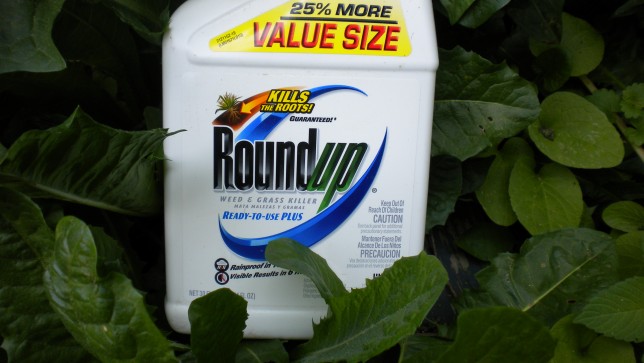EFSA and the EU Member States have finalised the re-assessment of glyphosate, a chemical that is used widely in pesticides. The report concludes that glyphosate is unlikely to pose a carcinogenic hazard to humans and proposes a new safety measure that will tighten the control of glyphosate residues in food.

Despite the mainly tragic nature of the EFSA report there is a very bright light in it – EFSA states that glyphosate herbicide formulations are likely to be genotoxic: “It is likely, therefore, that the genotoxic effects observed in some glyphosate-based formulations are related to the other constituents or “co-formulants” – Read all about this amazing admission here.
Source: EFSA
The conclusion will be used by the European Commission in deciding whether or not to keep glyphosate on the EU list of approved active substances, and by EU Member States to re-assess the safety of pesticide products containing glyphosate that are used in their territories.
FIND THE REAL TRUTH ON ‘SAFE’ LEVELS OF GLYPHOSATE HERE: detoxproject.org/glyphosate/
Ex-Head of EFSA: “EFSA IS CORRUPT”: drleonardcoldwell.com
WHO Cancer Expert: Glyphosate is Definitely Genotoxic
World Health Organization (2015): Glyphosate Is A Probable Human Carcinogen
A peer review expert group made up of EFSA scientists and representatives from risk assessment bodies in EU Member States has set an acute reference dose (ARfD) for glyphosate of 0.5 mg per kg of body weight, the first time such an exposure threshold has been applied to the substance.
Jose Tarazona, head of EFSA’s Pesticides Unit, said: “This has been an exhaustive process – a full assessment that has taken into account a wealth of new studies and data. By introducing an acute reference dose we are further tightening the way potential risks from glyphosate will be assessed in the future. Regarding carcinogenicity, it is unlikely that this substance is carcinogenic.”
Unlikely to be carcinogenic
The peer review group concluded that glyphosate is unlikely to be genotoxic (i.e. damaging to DNA) or to pose a carcinogenic threat to humans. Glyphosate is not proposed to be classified as carcinogenic under the EU regulation for classification, labelling and packaging of chemical substances. In particular, all the Member State experts but one agreed that neither the epidemiological data (i.e. on humans) nor the evidence from animal studies demonstrated causality between exposure to glyphosate and the development of cancer in humans.
EFSA also considered, at the request of the European Commission, the report published by the International Agency for Research on Cancer (IARC), which classified glyphosate as probably carcinogenic to humans.
The evaluation considered a large body of evidence, including a number of studies not assessed by the IARC which is one of the reasons for reaching different conclusions.
As well as introducing the ARfD, the review proposed other toxicological safety thresholds to guide risk assessors: the acceptable operator exposure level (AOEL) was set at 0.1 mg/kg body weight per day and an acceptable daily intake (ADI) for consumers was set in line with the ARfD at 0.5 mg/kg body weight per day.
Dr Tarazona added that EFSA will use the new toxicological values during its review of the maximum residue levels for glyphosate in food, which will be carried out in cooperation with Member States in 2016.
Next steps
The EFSA conclusion will inform the European Commission in deciding whether or not to retain the substance on the EU’s list of approved active substances. This is a condition for enabling Member States to authorise its continued use in pesticides in the EU.
For an explanation of the main findings of EFSA’s Conclusion on glyphosate, please consult our special non-specialist summary. EFSA has also produced a supplementary document that takes an in-depth look at some of the scientific issues that were highlighted during the assessment.
Background
Glyphosate is an active chemical substance widely used in a number of pesticide products and its use in Europe is subject to strict regulation. The EFSA peer review was carried out as part of the legal process required to renew authorisation of its use in Europe.
Following standard procedure for such renewals, the applicants supplied a dossier of relevant scientific information to a Member State – known as the rapporteur Member State (RMS) – to carry out an initial assessment. The dossier was assessed by the RMS, in this case Germany, and passed to EFSA to make a final evaluation of the evidence and conclusions in the file. This process is carried out by a peer review group made up of EFSA scientists and representatives from risk assessment bodies in all EU Member States.
What are maximum residue levels?
A maximum residue level (MRL) is the highest concentration of an active substance that is legally tolerated in food or feed when pesticides are applied correctly. EFSA is responsible for proposing MRLs in the EU, assessing the safety for consumers based on the toxicity of the pesticide, the levels expected to be found in food and the different food consumption habits of Europeans. The safety assessment is carried out using toxicological reference values such as the acute reference dose (ARfD).
What is an acute reference dose (ARfD)?
An ARfD is an estimated intake of a chemical substance in food, expressed on a bodyweight basis, that can be ingested over a short period of time, usually during one meal or one day, without posing a health risk.

















